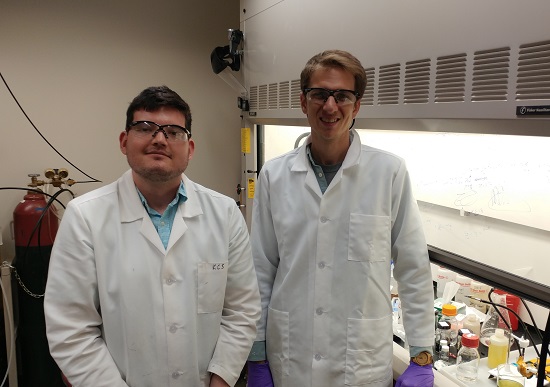Meet Dr. Nicholas Holubowitch and Gray Medina
Faculty-Student Team developed a low-cost technique to improve trace detection of explosives
This past summer, as many Americans celebrated a hiatus from work and school at events such as food and music festivals, fourth-year chemistry student Gray Medina and assistant professor Nicolas Holubowitch, Ph.D., explored ways to make public spaces safer.

Holubowitch and Medina spent their summer developing an inexpensive technique to detect picric acid and trinitrotoluene (TNT) electrochemically. The methodology can be transferred to detect a vast array of chemicals, according to Holubowitch, who envisions the creation of a handheld, battery-powered device.
“The purpose of our research was to make the detection of explosives easier, faster and less expensive,” said Holubowitch, who holds a doctorate in chemistry from the University College Cork in Ireland and teaches chemistry at Texas A&M University-Corpus Christi.
“In situations with large gatherings of people, wrongdoers can potentially inflict mass devastation with small, discrete explosive devices,” he continued. “A low-cost, portable device or system that could rapidly test individuals and baggage for the presence of traces of explosives from these devices is needed to prevent such attacks.”
Holubowitch and Medina conducted this research with the Awareness and Localization of Explosives-Related Threats (ALERT) Center of Excellence researcher professor Steve Beaudoin, Ph.D., at Purdue University, as part of the U.S. Department of Homeland Security (DHS) Summer Research Team (SRT) Program for Minority Serving Institutions. The ALERT Center of Excellence, led by Northeastern University, develops new means and methods to protect the nation from explosives-related threats.
The SRT Program is designed to increase scientific leadership at Minority Serving Institutions in DHS research areas. The program provides faculty and student research teams the opportunity to conduct research at university-based DHS Centers of Excellence.
Holubowitch and Medina spent their summer developing an inexpensive technique to detect picric acid and trinitrotoluene (TNT) electrochemically. The methodology can be transferred to detect a vast array of chemicals, according to Holubowitch, who envisions the creation of a handheld, battery-powered device.
Specifically, the technique involves polypyrrole, a multifunctional electrochemical material that provides efficient particle transfer during swabbing. While the utilization of polypyrrole is not novel, Holubowitch and Medina employed modifications that further enhanced polypyrrole swabbing efficiency.
“Our project ventured into unexplored territory regarding molecular imprinting of conductive polymers with explosive compounds,” said Holubowitch, “and we believe our techniques will be of interest to the wider community of sensors researchers.”
Medina spent much of his time conducting laboratory experiments and interpreting the data alongside Holubowitch, who was in charge of mapping out the research plans, performing advanced data analyses, conducting literature reviews and guiding Medina through introductory and advanced electrochemical concepts.
“It was great to know I wasn’t alone with a complex concept, and that there were other people in the lab to bounce ideas off of and get new unique perspectives from,” said Medina. “That said, the most challenging part of team research for me was communication, as I had to learn not to be afraid of asking questions.”
By the end of the summer, Medina had gained confidence not only in communicating with fellow scientists, but also in executing experiments independently and analyzing data.
The research experience was beneficial to Holubowitch as well. He learned to consider problems from his student’s perspective.
“I was lucky to have Medina as a motivated, curious and easy-going student,” Holubowitch said. “I realized it’s extremely important to stay attuned to the student’s capabilities, knowledge base and general well-being.
Medina’s interest in the research and excitement at the opportunity overall made for a collegial and mutually rewarding partnership.”
As a first-year assistant professor, Holubowitch believes the DHS SRT MSI program elevated his mentoring skills and jump-started his academic career.
“I honed critical, intangible skills like cultivation of a collaborative relationship with our mentor at Purdue, Steve Beaudoin, and interaction with his students,” he said. “Opportunities like this one spark many new ideas through direct interaction with other researchers, and more generally, I believe the experience of new places with new people ultimately adds a level of depth and enrichment to our lives.”
Medina is drawing upon his summer conversations with faculty and graduate students at Purdue to help narrow down his post-graduate pathways and determine his future career. He is a senior at Texas A&M University- Corpus Christi.
“Overall, I had a great time in the program and really enjoyed the research experience,” Medina said. “I’ve learned valuable team-working skills and would recommend other STEM students pursue an opportunity like this.”
The DHS SRT MSI Program is funded by DHS and administered through the U.S. Department of Energy’s (DOE) Oak Ridge Institute for Science and Education (ORISE). ORISE is managed for DOE by Oak Ridge Associated Universities.
